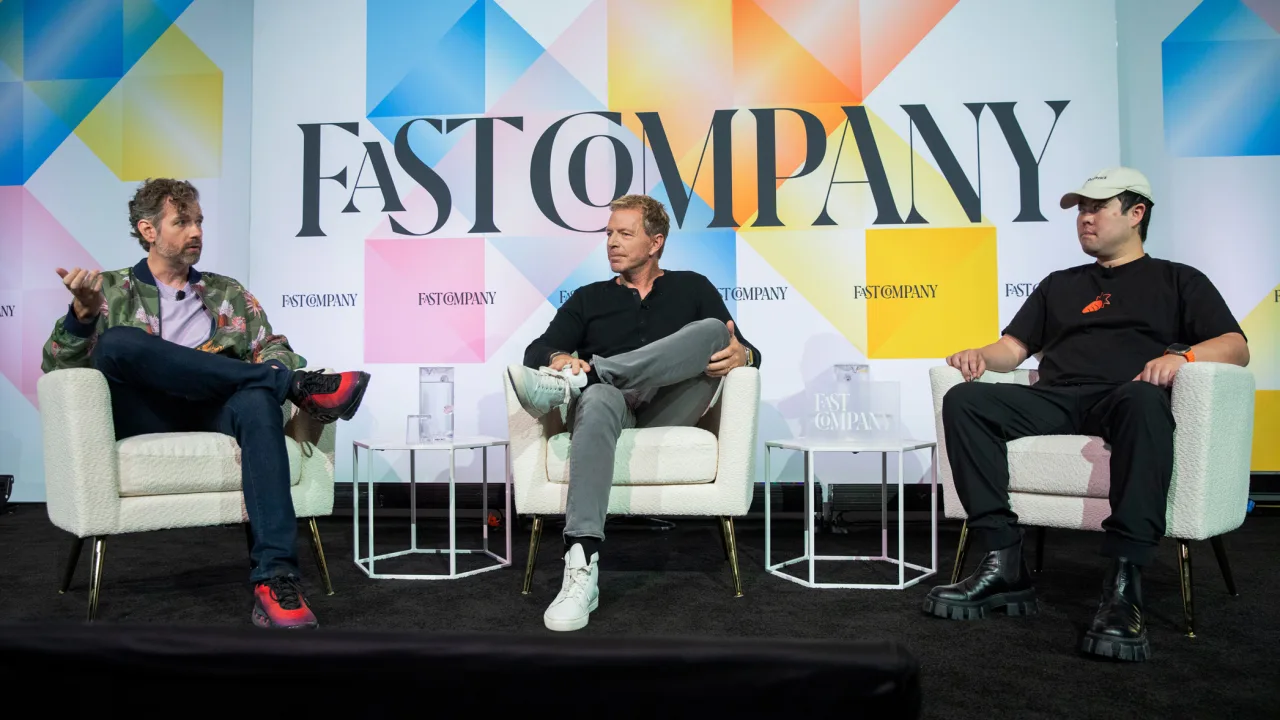AI hardware is in its flip-phone phase
Hardware has never been an easy business. Many of technology’s most high profile flops have been the result of a product that just didn’t make sense for its time. This past year, however, has been a special moment for hardware, as companies race to figure out what physical shape AI will take. There have already been casualties in this brief arms race. Humane, once valued at $850 million, has failed spectacularly to live up to its hype. The company is reportedly hemorrhaging money, as returns of its AI Pin outpace purchases. Then there’s Rabbit, the neon-orange brick designed with the buzzy studio Teenage Engineering. After selling 100,000 units, the gadget disappointed early adopters who wondered what, exactly, the gadget was for. Mark Wilson, Fast Company’s global design editor [Photo: Maja Saphir for Fast Company] It might seem as if there’s a curse on AI hardware startups, but the more boring truth is that getting the timing, the form factor, and the user experience of hardware right, is simply very hard to do. Try to do all of those things amid the fast moving developments of AI, and you’re bound to hit some snags. “Hardware is difficult; it’s painful; it’s expensive,” said Robert Brunner during a recent conversation at the Fast Company Innovation Festival. Brunner is the founder of the industrial design studio Ammunition, which has worked on products including Beats headphones and the ubiquitous Square card reader. He was joined on-stage by Fast Company’s global design editor, Mark Wilson, and Rabbit founder, Jesse Lyu, for a conversation about where AI hardware goes after its rocky early days. Launching too soon versus too late Brunner is currently working on an AI wearable “memory assistant” called Limitless. He concedes that there are special considerations when building AI hardware, but at the end of the day, it has to be something people want to use. “There’s enormous amount of technical sophistication [required],” he said. “There’s multiple processors, a lot of sensors, really a lot going on. But to the user, that doesn’t matter . . . it’s still about delivering something in people’s hands that they’re going to be compelled to bring into their lives.” Robert Brunner, founder and partner of Ammunition Group [Photo: Maja Saphir for Fast Company] Delivering that first truly compelling AI hardware product is proving to take time. But both Brunner and Lyu concur that, to get somewhere eventually, you have to start early—especially with tech giants including Apple, Samsung, and Google all working on the horizon of AI hardware. Lyu didn’t shy away from the feedback he’s received since shipping the R1 in spring 2024, which was objectively too early for the company to match high consumer expectations. “I’m very frank with the criticisms,” Lyu said. “I actually watch every single [piece of] YouTube coverage, see every Twitter shit post. I have a Notion file that I document by the timestamp of, ‘Oh, this guy complained about that, and that guy complained about this.’” Jesse Lyu, founder and CEO of Rabbit [Photo: Maja Saphir for Fast Company] “The fact is, the early bad reviews didn’t kill us, right?” he added. Lyu said that, now, around 5,000 people use the R1 daily, and his team has pushed 16 over-the-air updates to the R1 since its initial ship date. He views the R1 as an interactive product; and believes that it’s imperative for hardware startups embrace imperfect if they want to be part of a conversation. “If you’re a startup, you better ship early, period,” he said. Silicon Valley experienced a similar moment during the early days of cellphones. It was unclear which form factor would prevail—flip phone, slider, brick—until the iPhone hit the market. Today, AI hardware is in a similarly exploratory moment, and Brunner and Lyu believe that the trial and error is a necessary (if wasteful) phase to figuring out exactly what AI hardware is good for. “I think what everyone finds is they have to be brave,” Brunner said. “V1 they struggle, but V1.5 or V2 is always more successful. But you got to get to get to V1 first.”

Hardware has never been an easy business. Many of technology’s most high profile flops have been the result of a product that just didn’t make sense for its time. This past year, however, has been a special moment for hardware, as companies race to figure out what physical shape AI will take.
There have already been casualties in this brief arms race. Humane, once valued at $850 million, has failed spectacularly to live up to its hype. The company is reportedly hemorrhaging money, as returns of its AI Pin outpace purchases. Then there’s Rabbit, the neon-orange brick designed with the buzzy studio Teenage Engineering. After selling 100,000 units, the gadget disappointed early adopters who wondered what, exactly, the gadget was for.

It might seem as if there’s a curse on AI hardware startups, but the more boring truth is that getting the timing, the form factor, and the user experience of hardware right, is simply very hard to do. Try to do all of those things amid the fast moving developments of AI, and you’re bound to hit some snags.
“Hardware is difficult; it’s painful; it’s expensive,” said Robert Brunner during a recent conversation at the Fast Company Innovation Festival. Brunner is the founder of the industrial design studio Ammunition, which has worked on products including Beats headphones and the ubiquitous Square card reader. He was joined on-stage by Fast Company’s global design editor, Mark Wilson, and Rabbit founder, Jesse Lyu, for a conversation about where AI hardware goes after its rocky early days.
Launching too soon versus too late
Brunner is currently working on an AI wearable “memory assistant” called Limitless. He concedes that there are special considerations when building AI hardware, but at the end of the day, it has to be something people want to use. “There’s enormous amount of technical sophistication [required],” he said. “There’s multiple processors, a lot of sensors, really a lot going on. But to the user, that doesn’t matter . . . it’s still about delivering something in people’s hands that they’re going to be compelled to bring into their lives.”

Delivering that first truly compelling AI hardware product is proving to take time. But both Brunner and Lyu concur that, to get somewhere eventually, you have to start early—especially with tech giants including Apple, Samsung, and Google all working on the horizon of AI hardware.
Lyu didn’t shy away from the feedback he’s received since shipping the R1 in spring 2024, which was objectively too early for the company to match high consumer expectations. “I’m very frank with the criticisms,” Lyu said. “I actually watch every single [piece of] YouTube coverage, see every Twitter shit post. I have a Notion file that I document by the timestamp of, ‘Oh, this guy complained about that, and that guy complained about this.’”

“The fact is, the early bad reviews didn’t kill us, right?” he added.
Lyu said that, now, around 5,000 people use the R1 daily, and his team has pushed 16 over-the-air updates to the R1 since its initial ship date. He views the R1 as an interactive product; and believes that it’s imperative for hardware startups embrace imperfect if they want to be part of a conversation. “If you’re a startup, you better ship early, period,” he said.
Silicon Valley experienced a similar moment during the early days of cellphones. It was unclear which form factor would prevail—flip phone, slider, brick—until the iPhone hit the market. Today, AI hardware is in a similarly exploratory moment, and Brunner and Lyu believe that the trial and error is a necessary (if wasteful) phase to figuring out exactly what AI hardware is good for.
“I think what everyone finds is they have to be brave,” Brunner said. “V1 they struggle, but V1.5 or V2 is always more successful. But you got to get to get to V1 first.”






















